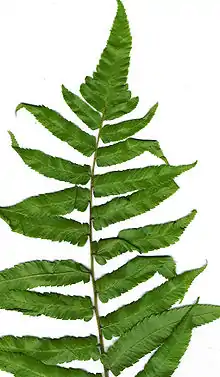Diplazium esculentum
Diplazium esculentum, the vegetable fern, is an edible fern found throughout Asia and Oceania. It is probably the most commonly consumed fern.[1]
| Diplazium esculentum | |
|---|---|
 | |
| Scientific classification | |
| Kingdom: | Plantae |
| Clade: | Tracheophytes |
| Class: | Polypodiopsida |
| Order: | Polypodiales |
| Suborder: | Aspleniineae |
| Family: | Athyriaceae |
| Genus: | Diplazium |
| Species: | D. esculentum |
| Binomial name | |
| Diplazium esculentum | |
| Synonyms | |
|
Athyrium esculentum | |
The genus Diplazium is in the family Athyriaceae, in the eupolypods II clade[2] of the order Polypodiales,[3] in the class Polypodiopsida.[4]
Description
This plant is a large perennial fern with ascending rhizome of about 20 cm high and covered with short rufous scales of about 1 cm long. The plant is bipinnate with long brownish petioles, and the petiole base is black and covered with short scales. The frond can reach 1.5 cm in length, and the pinnae is about 8 cm long and 2 cm wide.[5]
Uses
The young fronds are stir-fried and used in salads.[6][7]
It is known as pucuk paku and paku tanjung in Malaysia, pakô in the Philippines,[6] sayur paku in Indonesia, dhekia (ঢেকীয়া) in Assam "Dhenki Shaak (ঢেঁকি শাক) in Bengali ", paloi saag (পালই শাগ) Sylheti, ningro in Nepali,dingkia in Boro and linguda in northern India, referring to the curled fronds. In Thailand it is known as phak khut (Thai: ผักกูด). They may have mild amounts of fern toxins but no major toxic effects are recorded.[8]
Pharmacological effects
The extract also had alpha-glucosidase inhibitory activity.[9]
Gallery
 Yam phak khut, a Thai salad of fern leaves and pork
Yam phak khut, a Thai salad of fern leaves and pork Ensaladang pako (fern salad) at Larry Cruz's Abe Restaurant, in Manila
Ensaladang pako (fern salad) at Larry Cruz's Abe Restaurant, in Manila Habitat
Habitat
See also
References
- Anonymous. "Vegetable fern" (PDF). Use and production of D. esculentum. AVRDC (The World Vegetable Center). Archived from the original (PDF) on 26 April 2012. Retrieved 27 November 2011.
- Carl J. Rothfels; Anders Larsson; Li-Yaung Kuo; Petra Korall; Wen- Liang Chiou; Kathleen M. Pryer (2012). "Overcoming Deep Roots, Fast Rates, and Short Internodes to Resolve the Ancient Rapid Radiation of Eupolypod II Ferns". Systematic Biology. 61 (1): 490–509. doi:10.1093/sysbio/sys001. PMID 22223449.
- Maarten J. M. Christenhusz; Xian-Chun Zhang; Harald Schneider (2011). "A linear sequence of extant families and genera of lycophytes and ferns" (PDF). Phytotaxa. 19: 7–54. doi:10.11646/phytotaxa.19.1.2.
- Alan R. Smith; Kathleen M. Pryer; Eric Schuettpelz; Petra Korall; Harald Schneider; Paul G. Wolf (2006). "A classification for extant ferns" (PDF). Taxon. 55 (3): 705–731. doi:10.2307/25065646. JSTOR 25065646. Archived from the original (PDF) on 2008-02-26.
- Tanaka, Yoshitaka; Van Ke, Nguyen (2007). Edible Wild Plants of Vietnam: The Bountiful Garden. Thailand: Orchid Press. p. 37. ISBN 978-9745240896.
- Copeland EB (1942). "Edible Ferns". American Fern Journal. 32 (4): 121–126. doi:10.2307/1545216. JSTOR 1545216.
- Ethnobotanical Leaflets
- Gangwar Neeraj Kumar (2004). "Studies on pathological effects of linguda (Diplazium esculentum, Retz.) in laboratory rats and guinea pigs". Indian Journal of Veterinary Pathology. 28 (2).
- Chai TT, Yeoh LY, Mohd Ismail NI, Ong HC, Abd Manan F, Wong FC (2015) Evaluation of glucosidase inhibitory and cytotoxic potential of five selected edible and medicinal ferns. Tropical Journal of Pharmaceutical Research 14 (3): 449-454.